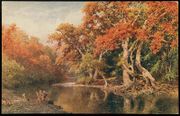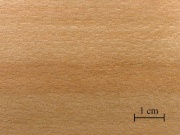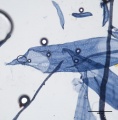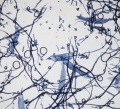Difference between revisions of "Sycamore"
JMcGlinchey (talk | contribs) |
|||
| (6 intermediate revisions by 3 users not shown) | |||
| Line 1: | Line 1: | ||
| − | [[File:95.1407d-SC48889.jpg|thumb|]] | + | [[File:95.1407d-SC48889.jpg|thumb|Egyptian coffin<br>MFA# 95.1407]] |
| + | [[File:Sycamore-MFA.jpg|thumb|Sycamores, California<br>MFA# 2014.6409]] | ||
== Description == | == Description == | ||
| − | 1) Any of several deciduous trees of the genus ''Platanus'', especially ''Platanus occidentalis'' ([ | + | 1) Any of several deciduous trees of the genus ''Platanus'', especially ''Platanus occidentalis'' ([[buttonwood|buttonwood]]) found in eastern North America. In Europe, they are commonly called plane trees. This tree has a pale, reddish-brown, close-grain wood that is tough and takes a fine polish. The wood is used for tool handles, rollers, flooring, furniture, crates, butcher blocks, musical instruments, and veneer. For an additional tree of the same genus, ''Platanus acerifoia'', see [[London%20plane|London plane]]. |
| − | 2) A type of maple tree, ''Acer pseudoplatanus'', native to Europe and Asia. Also called harewood, the tree has a light colored wood with a straight grain and even texture. It is used for inlays, veneer, and millwork. | + | 2) A type of maple tree, ''Acer pseudoplatanus'', native to Europe and Asia. Also called [[harewood]], the tree has a light colored wood with a straight grain and even texture. It is used for inlays, veneer, and millwork. |
| − | 3) A fig tree, ''Ficus sycamorus'', native to Africa and southwest Asia. | + | 3) A fig tree, ''Ficus sycamorus'', native to Africa and southwest Asia. This tree, a species of fig, is the sycamore tree mentioned in the Bible and used by ancient Egyptians to make mummy cases. |
| − | [[File:Am.sycamore_buttonwood.jpg|thumb|American Sycamore | + | [[File:Am.sycamore_buttonwood.jpg|thumb|American Sycamore (''Platanus occidentalis'')]] |
| + | == Synonyms and Related Terms == | ||
| − | + | 1. ''Platanus occidentalis''; American sycamore; American plane tree; western plane; buttonwood; buttonball; sycomore (Fr.) | |
| − | |||
| − | + | 2. ''Acer pseudoplatanus''; Harewood; English sycamore, sycamore maple, mock plane | |
| − | + | 3. ''Ficus sycamorus''; sycamore fig; sycomore; fig-mulberry | |
| − | + | == Physical and Chemical Properties == | |
| − | + | 1. Large tree growing to 40 m with spreading branches Bark=thin gray-brown exfoliating to form light patches. Fruit=ball containing tufted aches. Density = 22.43ppcf | |
| − | |||
| − | |||
| − | |||
| − | |||
Paper fiber type: hardwood, diffuse porous. Using transmitted light microscopy, pulp is identified by variable-sized vessels with alternate pitting. Perforations are scalariform, typically on both ends. Appearance with [[Graff "C" stain]]: dark blue, but varies with bleaching. Common pulping method: [[kraft process|kraft]]. | Paper fiber type: hardwood, diffuse porous. Using transmitted light microscopy, pulp is identified by variable-sized vessels with alternate pitting. Perforations are scalariform, typically on both ends. Appearance with [[Graff "C" stain]]: dark blue, but varies with bleaching. Common pulping method: [[kraft process|kraft]]. | ||
| Line 33: | Line 30: | ||
File:64_Sycamore_100X_Tan2.jpg|Sycamore (''Platanus occidentalis'') | File:64_Sycamore_100X_Tan2.jpg|Sycamore (''Platanus occidentalis'') | ||
File:64_Sycamore_100X_Tran2.jpg|Sycamore (''Platanus occidentalis'') | File:64_Sycamore_100X_Tran2.jpg|Sycamore (''Platanus occidentalis'') | ||
| + | File:Sycamore 40x.jpg|American Sycamore paper pulp stained with Graff "C" stain | ||
| + | File:Sycamore 10x2.jpg|American Sycamore paper pulp stained with Graff "C" stain | ||
</gallery> | </gallery> | ||
| − | + | ==Resources and Citations== | |
| − | == | + | * Alden Identification Services, Microscopic Wood Identification: [https://wood-identification.com/wood-types/ Link] |
* R. J. Gettens, G.L. Stout, ''Painting Materials, A Short Encyclopaedia'', Dover Publications, New York, 1966 | * R. J. Gettens, G.L. Stout, ''Painting Materials, A Short Encyclopaedia'', Dover Publications, New York, 1966 | ||
| Line 46: | Line 45: | ||
* F. H. Titmuss, ''Commercial Timbers of the World'', The Technical Press Ltd., London, 1965 Comment: 22-43 ppcf | * F. H. Titmuss, ''Commercial Timbers of the World'', The Technical Press Ltd., London, 1965 Comment: 22-43 ppcf | ||
| − | * ''Encyclopedia Britannica'', http://www.britannica.com Comment: sycamore" | + | * ''Encyclopedia Britannica'', http://www.britannica.com Comment: sycamore" [Accessed November 7, 2001]. |
* Edward Reich, Carlton J. Siegler, ''Consumer Goods: How to Know and Use Them'', American Book Company, New York City, 1937 | * Edward Reich, Carlton J. Siegler, ''Consumer Goods: How to Know and Use Them'', American Book Company, New York City, 1937 | ||
| − | * | + | * Virginia Tech Dendrology website at www.fw.vt.edu/dendro/dendrology/main.htm (Accessed Dec. 9, 2005) |
| − | * Wikipedia | + | * Wikipedia: http://en.wikipedia.org/wiki/American_Sycamore (Accessed Dec. 9, 2005) |
* ''CRC Handbook of Chemistry and Physics'', Robert Weast (ed.), CRC Press, Boca Raton, Florida, v. 61, 1980 Comment: density=24-37 ppcf (0.40-0.60 g/cm3) | * ''CRC Handbook of Chemistry and Physics'', Robert Weast (ed.), CRC Press, Boca Raton, Florida, v. 61, 1980 Comment: density=24-37 ppcf (0.40-0.60 g/cm3) | ||
| Line 58: | Line 57: | ||
* George Savage, ''Art and Antique Restorer's Handbook'', Rockliff Publishing Corp, London, 1954 | * George Savage, ''Art and Antique Restorer's Handbook'', Rockliff Publishing Corp, London, 1954 | ||
| + | * Marja-Sisko Ilvessalo-Pfäffli. ''Fiber Atlas: Identification of Papermaking Fibers'' (Springer Series in Wood Science). Springer, 1995. | ||
| + | * Walter Rantanen. "Fiber ID Course." Integrated Paper Services. June 2013. Lecture. | ||
[[Category:Materials database]] | [[Category:Materials database]] | ||
Latest revision as of 10:27, 4 October 2020
Description
1) Any of several deciduous trees of the genus Platanus, especially Platanus occidentalis (Buttonwood) found in eastern North America. In Europe, they are commonly called plane trees. This tree has a pale, reddish-brown, close-grain wood that is tough and takes a fine polish. The wood is used for tool handles, rollers, flooring, furniture, crates, butcher blocks, musical instruments, and veneer. For an additional tree of the same genus, Platanus acerifoia, see London plane.
2) A type of maple tree, Acer pseudoplatanus, native to Europe and Asia. Also called Harewood, the tree has a light colored wood with a straight grain and even texture. It is used for inlays, veneer, and millwork.
3) A fig tree, Ficus sycamorus, native to Africa and southwest Asia. This tree, a species of fig, is the sycamore tree mentioned in the Bible and used by ancient Egyptians to make mummy cases.
Synonyms and Related Terms
1. Platanus occidentalis; American sycamore; American plane tree; western plane; buttonwood; buttonball; sycomore (Fr.)
2. Acer pseudoplatanus; Harewood; English sycamore, sycamore maple, mock plane
3. Ficus sycamorus; sycamore fig; sycomore; fig-mulberry
Physical and Chemical Properties
1. Large tree growing to 40 m with spreading branches Bark=thin gray-brown exfoliating to form light patches. Fruit=ball containing tufted aches. Density = 22.43ppcf
Paper fiber type: hardwood, diffuse porous. Using transmitted light microscopy, pulp is identified by variable-sized vessels with alternate pitting. Perforations are scalariform, typically on both ends. Appearance with Graff "C" stain: dark blue, but varies with bleaching. Common pulping method: kraft.
Additional Images
Resources and Citations
- Alden Identification Services, Microscopic Wood Identification: Link
- R. J. Gettens, G.L. Stout, Painting Materials, A Short Encyclopaedia, Dover Publications, New York, 1966
- G.S.Brady, Materials Handbook, McGraw-Hill Book Co., New York, 1971 Comment: p. 788
- Ralph Mayer, A Dictionary of Art Terms and Techniques, Harper and Row Publishers, New York, 1969 (also 1945 printing)
- F. H. Titmuss, Commercial Timbers of the World, The Technical Press Ltd., London, 1965 Comment: 22-43 ppcf
- Encyclopedia Britannica, http://www.britannica.com Comment: sycamore" [Accessed November 7, 2001].
- Edward Reich, Carlton J. Siegler, Consumer Goods: How to Know and Use Them, American Book Company, New York City, 1937
- Virginia Tech Dendrology website at www.fw.vt.edu/dendro/dendrology/main.htm (Accessed Dec. 9, 2005)
- Wikipedia: http://en.wikipedia.org/wiki/American_Sycamore (Accessed Dec. 9, 2005)
- CRC Handbook of Chemistry and Physics, Robert Weast (ed.), CRC Press, Boca Raton, Florida, v. 61, 1980 Comment: density=24-37 ppcf (0.40-0.60 g/cm3)
- George Savage, Art and Antique Restorer's Handbook, Rockliff Publishing Corp, London, 1954
- Marja-Sisko Ilvessalo-Pfäffli. Fiber Atlas: Identification of Papermaking Fibers (Springer Series in Wood Science). Springer, 1995.
- Walter Rantanen. "Fiber ID Course." Integrated Paper Services. June 2013. Lecture.







